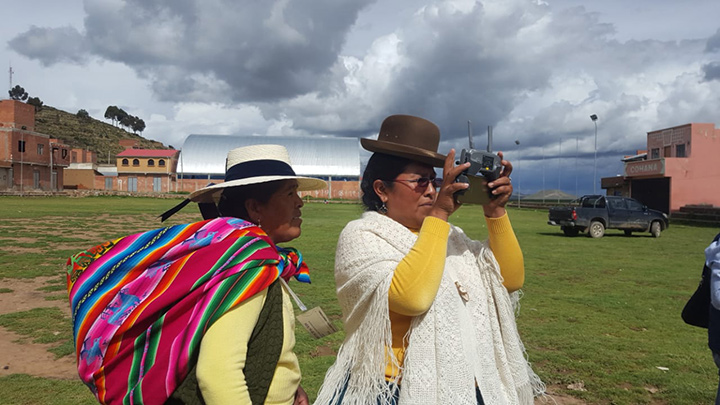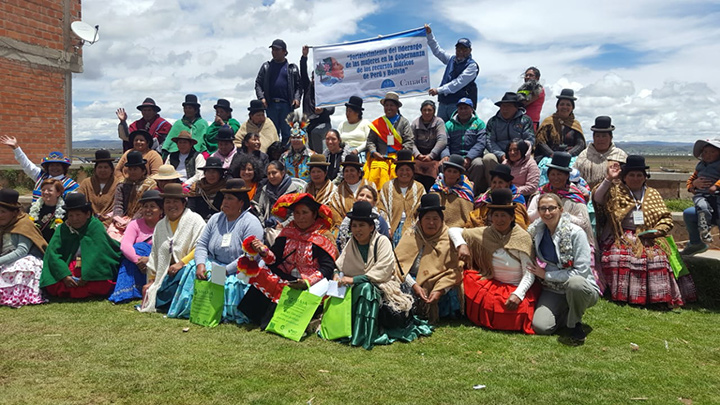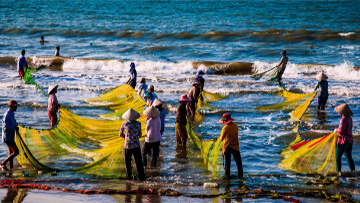Indigenous Voices from Peru, Bolivia, and Canada: Protecting Lake Titicaca

Indigenous women lead a unique water-conservation project on the shores of Lake Titicaca.
Across the globe, Indigenous peoples are leading the way in conservation efforts.
Their special relationship with ancestral lands and territory has fostered important knowledge. This knowledge can help protect the planet’s biodiversity, combat climate change and maintain ecosystems.
Indigenous peoples are among the most marginalized and disadvantaged groups of people in the world.
Despite unique customs and cultures, Indigenous people face similar challenges:
- Protection of their rights as distinct peoples;
- Recognition of their identities and ways of life;
- Rights to their traditional lands, territories, and natural resources
A unique Canada Fund for Local Initiatives (CFLI) water-conservation project in Lake Titicaca provided an opportunity for Indigenous women leaders from Bolivia and Peru to meet Alex Wells. Wells is a world-champion hoop dancer from Lil’wat First Nation in British Columbia, Canada. Together, they shared their cultures and experiences, while discussing the role of indigenous people in protecting their ancestral lands.
Pollution plagues “sacred” Lake Titicaca
Lake Titicaca is the highest navigable body of water in the world, high in the Andean mountains. Situated on the border between Peru and Bolivia, the local Aymara people recognize it as a sacred lake. According to Incan mythology, Lake Titicaca is the birthplace of the sun.
This world-famous lake, however, is highly contaminated.
Trash from tourists, untreated sewage, and byproducts from natural resource development are dumped in the lake every day. Toxic levels of mercury and lead are causing health problems in humans and animals.
Indigenous women leaders from local Aymara and Quechua communities are now taking action to protect their water supply.
Indigenous women monitor water contamination and advocate for sustainability
Through the CFLI, the Canadian Embassy to Peru and Bolivia partnered with Agua Sustentable. This local non-profit organization empowers local Indigenous women leaders to measure and report on the lake’s water quality. They advocate with local and national authorities.
Agua Sustentable received Can$33,000 to support the creation and training of “Women United for Water Network of Lake Titicaca”. The cross-border group consists of 86 Indigenous women from regions across the lake. This network is increasing the role and visibility of Indigenous women in the lake’s governance and management.
The CFLI also supports the provision of drone technology, pH monitors and technical training, enabling the women to monitor and survey pollution levels.


The women completed five water monitoring campaigns in four different provinces surrounding the lake. At each location, the women measured pH, temperature, electrical conductivity, dissolved solids, and dissolved oxygen levels of the lake.
The water quality information, uploaded to the Suma Uma app, compiles the data into a user-friendly format. That data demonstrates the extent of Lake Titicaca’s water contamination. It can help inform policy decisions and water conservation projects.
Women’s voices and leadership are now at the forefront of discussions about the lake’s sustainability
The women’s leadership on the preservation of Lake Titicaca is helping break down barriers in isolated highland communities where traditional gender stereotypes thrive.
Women community leaders now feel confident to share their findings in meetings with Peruvian partners and government representatives.
Indigenous women are engaging in effective dialogue with decision makers about the future of Lake Titicaca.
Shared Indigeneity, from British Columbia to Lake Titicaca
The Indigenous women of Lake Titicaca also impressed Canadian hoop dancer, Alex Wells, from the Lil’wat First Nation in British Columbia.
The Embassy invited Wells, a three-time world champion, to connect with Peruvian and Bolivian Indigenous peoples. This was part of the celebration of 40 years of international development cooperation between Canada and Bolivia and 75 years of diplomatic relations between Canada and Peru.

When Wells arrived, members of the local Indigenous community felt a strong connection to someone from so far away. Their shared experiences as Indigenous peoples brought them together. “Participants were awed as they saw and heard from someone to their like, akin to them, even though they speak in different languages”, shared Ana Maria Millares, President of the Women United for Water Network of Lake Titicaca.
Inspired by the leadership and courage of the Indigenous women, Wells spontaneously decided to perform his traditional, “Creation” dance. By manipulating the hoops to recreate symbolic figures such as animals and plants, the hoop dance tells his peoples’ stories about the creation of life. It sparked a connection between the Indigenous communities.
“You only see this in the movies.”
“I felt an immediate connection, a cultural attraction with the Indigenous community members I met”, Alex explained. “By travelling the world and sharing my peoples traditions and dances I feel increasingly part of a globalization of Indigenous cultures with spiritual connections coming together in this generation”, he added.
Taking action against pollution, in Canada, Peru and Bolivia
Lil’Wat means “where the two rivers meet” in the Indigenous language of Lillooet. Alex described his own people’s experiences with protection and management of their lands and waters. The local women participants recognized their shared Indigenous values, including a profound respect for nature and environmental concerns.

Canada has more fresh-water lakes than any other country in the world. Nearly 20% of the world’s surface freshwater is in the Great Lakes. Canada is deeply invested in the protection of these natural resources. The Great Lakes Water Quality Agreement (GLWQA) and the Canada-Ontario Agreement on Great Lakes Water Quality and Ecosystem Health identifies priorities and actions needed to restore and protect the chemical, physical and biological integrity of the Great Lakes. In 2015, these agreements were shared with Peru and Bolivia as potential models for water conservation.
Immediately following Wells’ performance, the 60 women participants and Embassy staff gathered to clear debris from the lakeshore.
Following the event, the women leaders shared that they felt empowered to make Lake Titicaca and the Desguadero River safe. They understand that protection of their surroundings is both worthwhile and achievable.
Indigenous women lead the way
Plans to expand the project are already underway, including:
- public advocacy projects in twelve local public schools to increase youth awareness of conservation issues and techniques;
- the integration of 50 additional women leaders from the Lake Titicaca basin to the existing network;
- contributions to policy development;
- enhanced community awareness and training;
- the launch of a YouTube channel to promote the work of the women’s network and deliver training on innovative approaches to water conservation.
Canada is committed to advancing Indigenous issues at home and abroad, including the restoration and protection of their traditional lands and waters and the empowerment of Indigenous women as leaders in their communities.
Related links
External links
- Date Modified:


